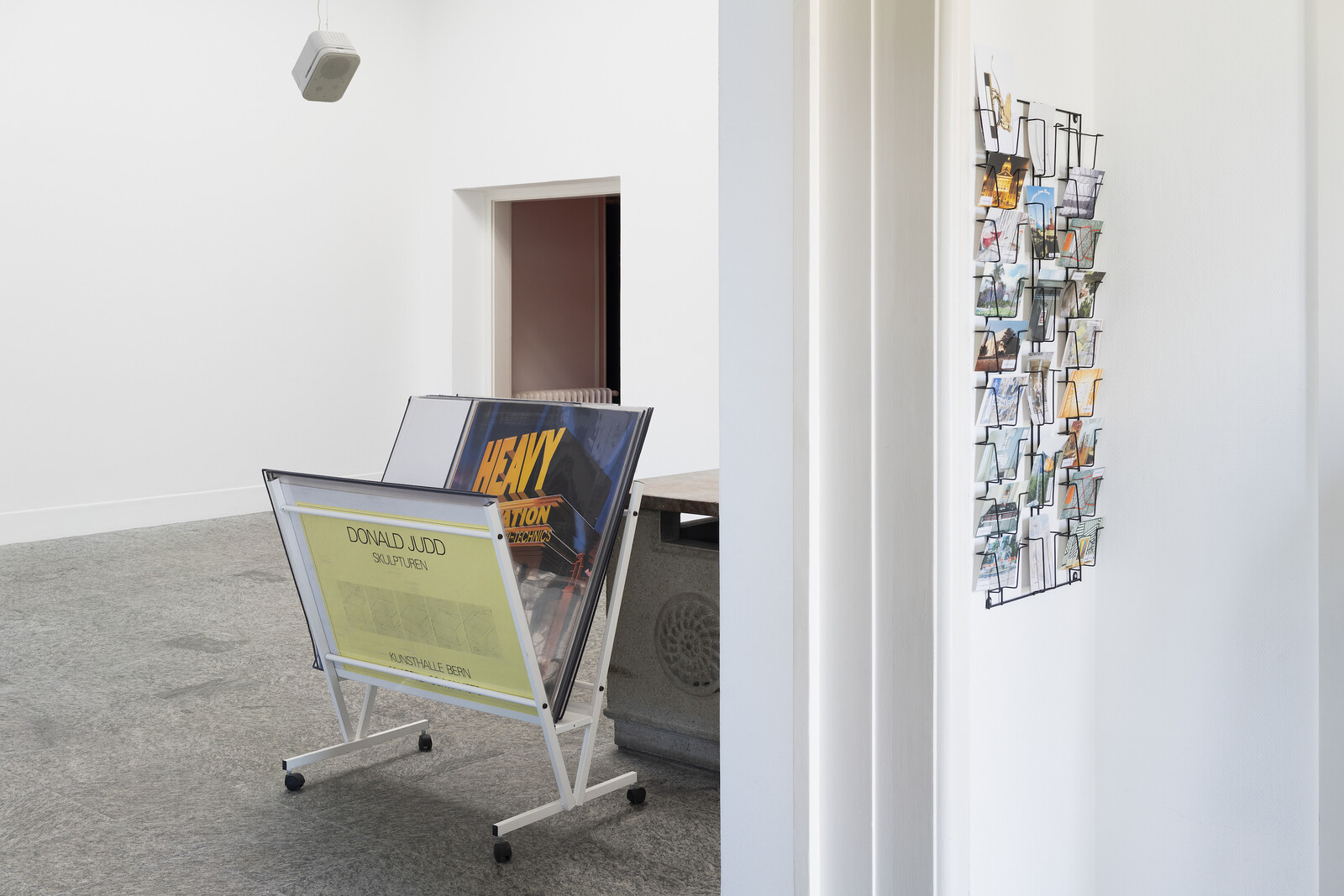Unassuming objects—such as grocery cartons, essential supplies, orange peels, shopping carriers, polythene bags, suitcases, a towel, and a lighter—occupy a large hall of Kunsthalle Bern. Elsewhere in the space, a discarded scratch card lies on the floor beside stacked chairs and potted foliage on wheels. Assembled by artist duo Valentina Ornaghi and Claudio Prestinari, these tableaux stage a material sensorium of the ubiquitous. Fragments of Campo del Cielo meteorite are dispersed across the walls in various permutations as well: a cosmic extension of the morsels that constitute the ordinary.
In “Heavy Rotation Infra-habibi-technics,” makeshift infrastructures such as these evoke motion and traffic as well as incidents and happenings that are furtive, off-ledger, or premised on informal networks. These unmoored objects—available to touch and vulnerable to pilfering—are presented in ways that resist easy attribution to the contributing artists, attesting to a different logic of exhibition-making. This reluctance to discretize the works further manifests in the illustration of weather patterns that substitutes for a labelled floor plan, indicating a merging of indistinct “atmospheres.”
The orange peels, for instance, refer to a film shown in an enclosed space on the floor below. In Cow Heaven Brawl Cloud (2023), the artist Laura Nitsch films two women driving a car on Alpine roads through turns and twists indicated only through subtle, practiced motions of the hand. At one point, one of the women peels an orange before they both consume it. These peels are dispersed across the gallery’s floors and tables in a cinematic spillage of index.
The exhibition, mounted by curator Lantian Xie with other artists and allied bodies (for all of whom he uses the equalizing label “protagonists”) generates a sense of being witness to a story that is already in progress. The range of sonic narrations comprising Placeholder (2023) by Kaushal Sapre, Aasma Tulika, Alla Semenovskaya, and Aarushi Surana, play on speakers suspended from ceilings and affixed to thresholds. The ear catches fragments from the overlapping voices, including speech acts around internet infrastructures, hotlines, undersea cables, and tutorials. Responding to the surrounding works, Placeholder produces meaning through a gestalt effect, drawing out subterranean connections and suturing loose ends.
In İpek Hamzaoğlu’s 2023 film Passport Party, shown on the ground floor, several bodies sway to techno in a dimly lit bar while passing a series of instructional relays: “Go in the afternoon and take a number, but don’t wait in line. Ask for the person she was telling you about.” The words appear on the screen as subtitles, and do not point to particular bodies for their pronouncement; they could be anybody’s in the crowd. These para-protocols gesture towards the gaps in institutional knots, and the fleeting contact that enables transactions in trust. The soundtrack is woven through with whispered voices discussing the formalities surrounding travel visas, which registers as an exercise in developing a lexical intimacy with the bureaucratic apparatus.
An intriguing work by graphic designer Aarushi Surana is displayed in a room facing Hamzaoğlu’s film. In collaboration with fashion brand FRAME, Surana designed a T-shirt that hangs loose on a set of drums stationed in a corner. Only by straightening out its creases does the viewer reveal the T-shirt’s design, and bring it into participation with the show’s matrix of collisional references: a graphic poster, printed in white against black, of Indian director Yash Chopra’s immensely popular Hindi film Chandni (1989). Through an enduring vocabulary of song-and-dance sequences characteristic of mainstream Hindi films, Chandni consolidated the Swiss imaginary for Indian audiences as an aspirational holiday destination, resulting in heavy tourist traffic from the subcontinent ever since.
The reference is supported by the pamphlets from “Habibi Tours and Travels” scattered throughout the gallery. Carrying an idyllic image of the country as a representative graphic, they advertise “the best of Switzerland in one itinerary.” But a Brown body can only access this imaginary through long periods of waiting in queues at the visa office, alongside considerable expense, intense scrutiny, and bureaucratic rigmarole. The poster on Surana’s T-shirt further ascribes horror to an otherwise romantic musical through its choice of a noir syntax; perhaps a similar horror for instruction animates the impulse to jump the queue in Passport Party. That the T-shirt is sold as merchandise at the museum’s gift shop and online complicates its position as an “artwork.” In refusing this status by expanding into the market through reproductions, the work seeks other, more viable forms of persistence.
Surana also designed the promotional graphic: a bootlegged iteration of the widely recognizable logo of 20th Century Studios, in which the film production company’s name is replaced with the exhibition title. Refraining from literally citing the original yet borrowing its potency, the appropriated visual relies on public memory for its advertisement. Mobilizing a universal template with vernacular intention, the work affirms the exhibition’s wider rejection of absolute authorship as a methodology.
Yet there are authors even of these infidelities, which makes said premise untenable. Working with and against consolidated structures of meaning-making and commanding different degrees of attention, “Heavy Rotation” rejects narrativization in favor of a generative illegibility―one that de-centers normative ways of looking and listening. But this illegibility also overtakes the framework and renders many connections insular, leading me to wonder if the exhibition performs opacity as a tactic. Designed as an elliptical assemblage, the exhibition attempts to create an elastic image of the Alpine, but measures its tangents too precisely for the viewer to adequately appreciate its scope.





